#1860s undergarment
Explore tagged Tumblr posts
Text
Direct link to the pattern!
youtube
“Yet Another 19th Century Chemise Video — 1860s Ballgown Part 3” by Rue’s Sewing Adventures
In which I procrastinate for weeks on a thing that ends up taking me a day to make 🙃
The pattern Rushalee uses is a freebie from @mimicofmodes’s blog! Always fun to see the shared knowledge in the historical costuming community.
23 notes
·
View notes
Text
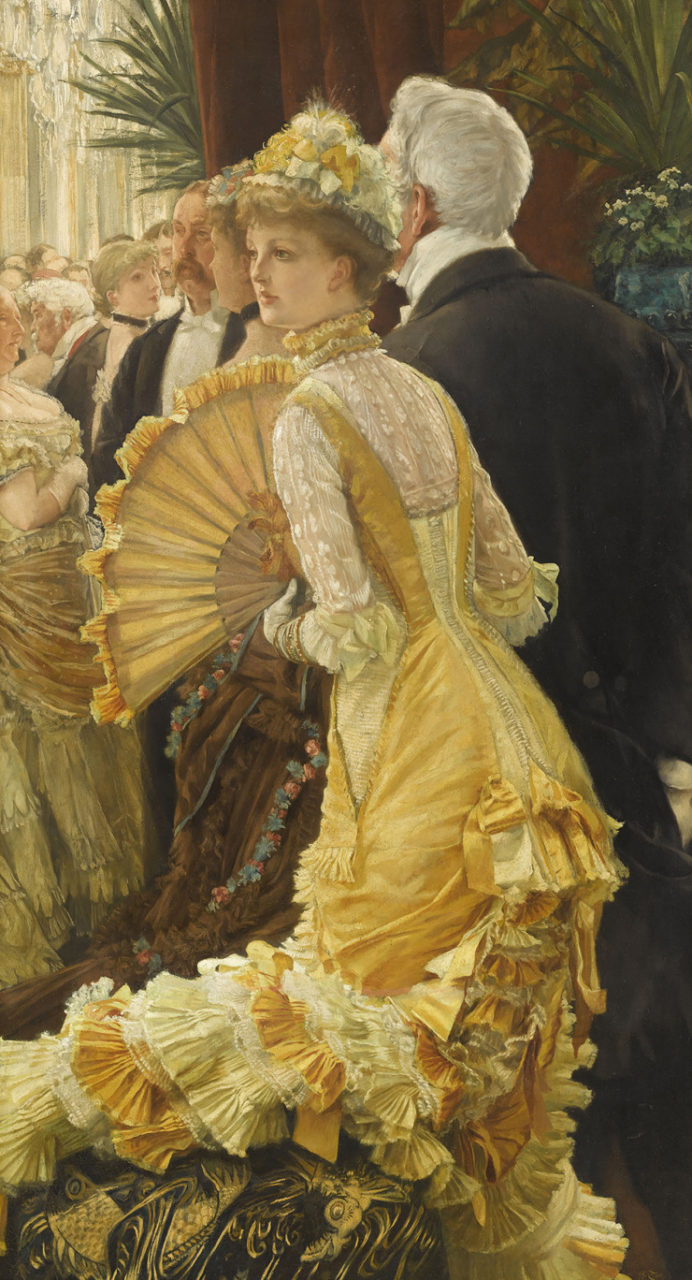
figure 1
James Tissot (French, 1836–1902) • The Ball • 1878
Figure 1: According to French fashionistas, Tissot got the hat all wrong. Apparently hats were inappropriate as evening wear, particularly at a ball. Indeed, when perusing fashion plates of the late 1870s, formal evening attire never included hats.
For formal evening events, hair was styled in elaborate braids, buns, and curls, often adorned with silk flower sprays and fancy clips and combs. Silk flowers were also sometimes used as embellishments for dresses.
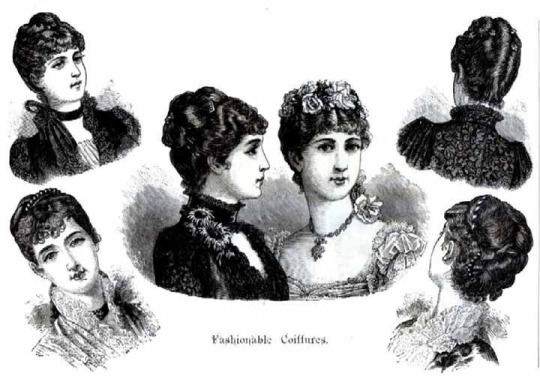
A Tissot creation likely inspired by the fashion plates of the day, the evening or ball dress in figure 1 features a bow right at the buttocks followed by a cascade of layered pleats, lace, and ruffles. This style was commonly referred to as The Princess Line dress. Created in Great Britain by Charles Frederick Worth in the form of Princess Alexandra's wedding dress, it soon took off as the latest dress style craze.

French hand fan • Ivory, paper, gouache, mother-of-pearl, metal • 1860-70 • Brooklyn Museum Costume Collection at The Metropolitan Museum of Art
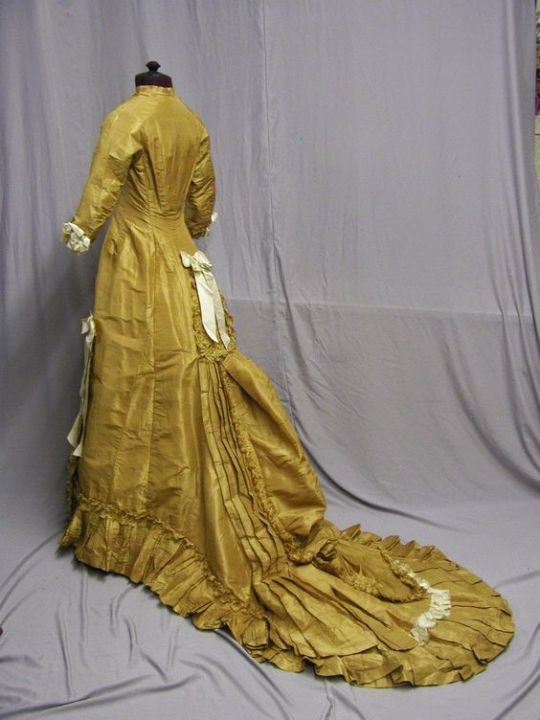
Figure 2
Figure 1: In the mid 1870s, the bustle evolved into a less protruding fashion feature and eventually, toward the end of the decade gave way to the mid-bustle or natural form era. This transformation took place from 1877 through approximately 1882. Compared to the large, overstuffed bustles of the early 1870s, the Mid-Bustle, or Natural Form dress created a more vertical, slimming silhouette. The waist was undefined and embellishments began at the back of the waist, or even below it.
Figure 2: It is difficult for a fashion history novice like me to define the correct occasion for this particular dress. It's perhaps a special occasion day or afternoon dress and hence less embellished. Or perhaps the modest satin bow at the hip gives it away as just a regular day dress. In one entry at Lily Absinthe's blog, she states that a semi-train is usually indicative of a day or afternoon special occasion dress. All I know for sure is that I adore the lovely vertical pleated train!

Princess Line dress • 1878-1880 (made) • Unknown designer and maker, likely from Great Britain • Virginia and Albert Museum
Blue and gold Jacquard-woven silk made with a fitted bodice and narrow skirt drawn back into drapes at the back, and rusched silk trim. It has elbow-length sleeves and a square neckline, which are both trimmed with machine-lace. This is a day or afternoon dress, likely worn at home. More views of this dress can be seen here.

Attire appropriate for a hat.
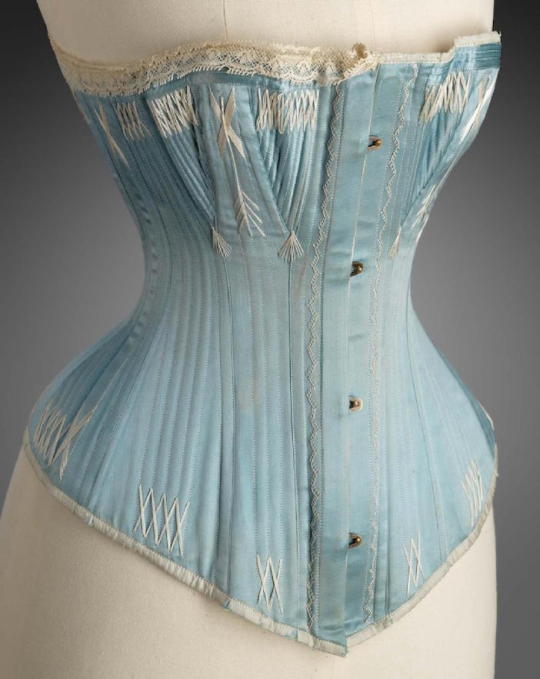
Of course, the ultra-slim silhouette of the princess dress was restrictive and necessitated increasingly tighter undergarments like corsets and girdles, further restricting movement. Poor working women who engaged in hours of manual labor could not afford either the latest fashions nor the restricted movement.
Sources:
Lily Absinthe
The Metropolitan Museum of Art Costume Institute , New York City
Fashion History Timeline (FIT, Fashion Institute of Technology, New York City
V & A (Victoria & Albert Museum, London
#fashion history#late 1870s fashion history#princess line dress#james tissot#art history#french fashion history#late 1870s fashion plate#french hand fan#victorian fashion#historical fashion#victorian era#19th century fashion#the resplendent outfit blog#french fashion#historical painting
80 notes
·
View notes
Note
Hello hello! I have gotten myself into an American Civil War era ball in November and I was wondering if you had any input on formal dress from the era! I've never done reenactment before but I would love some input on what I should wear!
That sounds very cool! I hope you'll have great time there when it eventually comes! :D
I'll go through all the garments and accessories that would have been used at the time, but obviously limitations of reality might get in the way of some parts. I'll give my opinion on what I think is more and less necessary to embody the era, but I've never done reenactment either so I can't really say for sure what is the expected level of historical accuracy, maybe someone with some experience of reenactment can chime in. But you'll be the best judge on what you can realistically get/make. Think of this as background info.
So the years we are looking at are 1861-65. I'll start from underlayers towards outer layers.
Shift and drawers
By 1860s drawers were used by most women with their shifts. The shift had wide neckline, small sleeves and often a bit of lace trimming. The sleeves could be wide like in the examples, but less often they might be small poofs. It was roughly knee length and still quite often made from white linen, but white cotton too.
Linen shift from mid 1800s US, and a linen shift from 1861-65.

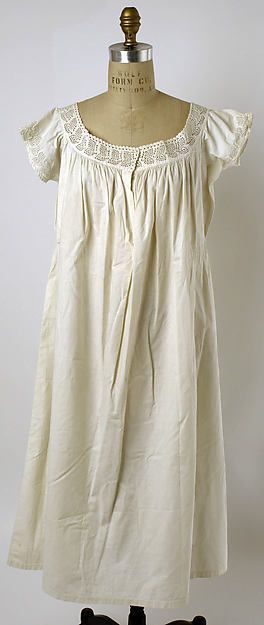
The drawers were very simple in design. They most often split crotch seam, meaning the crotch seam wasn't sewn closed and the waistband was the only thing holding the pieces together. This made it easier to use the bathroom. They reached around mid-calf, sometimes just over the knees, but ankle length was too long. 1860s drawers were very full and usually had simple lace and/or frills at the hem. They were also made from either linen or cotton at the time.
The first example is from 1863 Peterson's Magazine, where pattern for joined drawers are marketed as new, but it's still very much patterned in a way where the drawers don't need to be taken down when using bathroom. It would be still pretty rare. Then drawers from 1860s US.
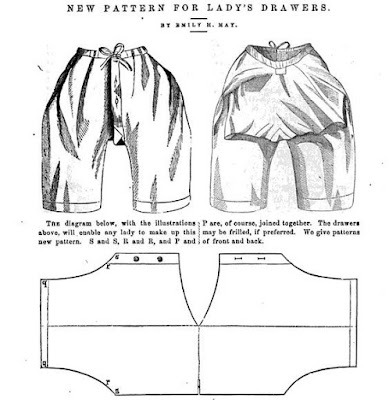

I would say basically any shift with short sleeves and wide enough neckline works here or really in place of that even almost any similarly shaped under dress, but it's very crucial to have something under the corset. If a shift isn't easily available, the replacing dress should be thin so it's not super hot, loose so it doesn't need closures that might cause chafes under the corset and preferably linen or at least cotton, so it's not sweaty and feels comfortable. Linen is really the superior undergarment material as it's anti-bacterial, very breathable and easy to wash, cotton was only contending with it for very Victorian reasons. The drawers are not necessary, not everyone used them at the time. If you don't feel comfortable not wearing any underpants (which was the other option at the time), I do recommend them since using a bathroom with the crinoline and underpants you have to take down is pretty hard.
Corset
1860s corset was fairly short compared to earlier and later corsets, and usually wouldn't reach very far on the hips. It wasn't necessary as the waistline was just above the natural waistline and the skirt was very wide so the shape of the hips would be completely covered. The corset used in formal settings like balls was usually heavily boned but for the same reasons as why the corset itself was relatively short, the bones didn't necessarily reach beyond the waistline. For these reasons even the heavily boned corsets left very large range of movement for the torso. As it was typical for the whole Victorian era, the corset was closed at the front with a busk and had lacing in the back.
The boning was usually just whalebone, metal often only used in the busk. The fabric was reinforced with most often with cotton twill or canvas. Especially in case of these fancier corsets used with evening gowns, the corset often had a silk fashion fabric, which could be white like other undergarments or colorful.
Silk corset from 1864 Britain/France, and cotton wedding corset from 1865-67 US.
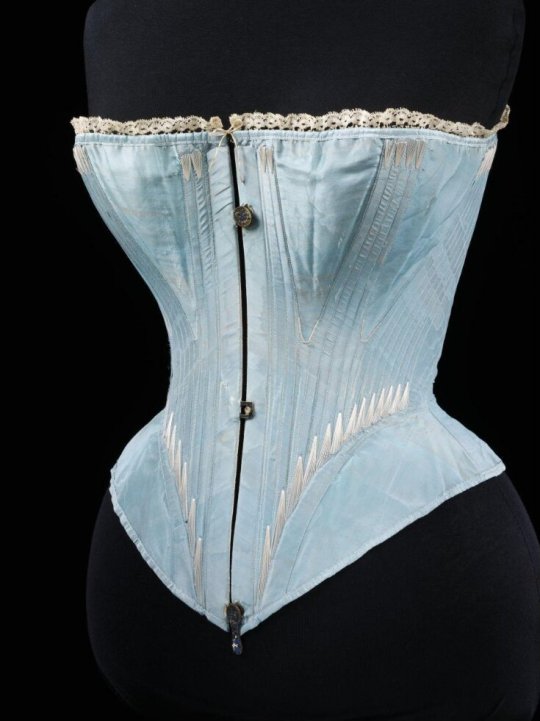
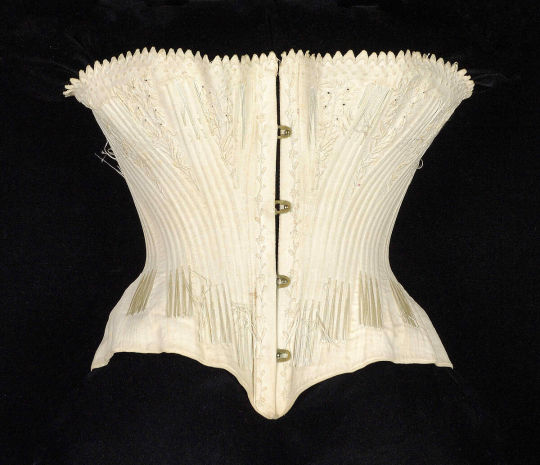
Corset really is very necessary to pull of the ball gown of this era. Not just because it's very crucial in getting the silhouette, but also because it makes it easier to wear the large skirt as the corset distributes it's weight across the torso and supports the torso too. I do think any Victorian corset works here well enough as they are roughly similarly shaped. Because the crinoline is very light, the skirt is lighter than it looks, so even other less structured supportive garments that give even somewhat similar shape could work if Victorian corsets are not an option, like Regency stays or Edwardian corsets or even some modern corset. From what I've heard about reenactment events, I would prioritize having corset (or similar) that fits you and you know you can wear for a long period of time over historical accuracy and the right silhouette. (Corset often needs to be broken in like leather shoes, because the whalebones will shape into the body.)
Crinoline
Crinoline is a crucial part of the underlayers to achieve the silhouette of this era. The silhouette went through some changes even in the first half of 1860s. It started as quite similar to late 1850s silhouette of very large and round, though already in 1861, the volume was more focused in the back. In the following years the skirt would become less round, but wider and the volume would increasingly lean to the back. The skirt would reach it's widest point with massively long back, almost like a very wide bustle, in 1865.
Crinoline from 1860-62 Spain, and another from 1865. You can see the progression quite well between these two.
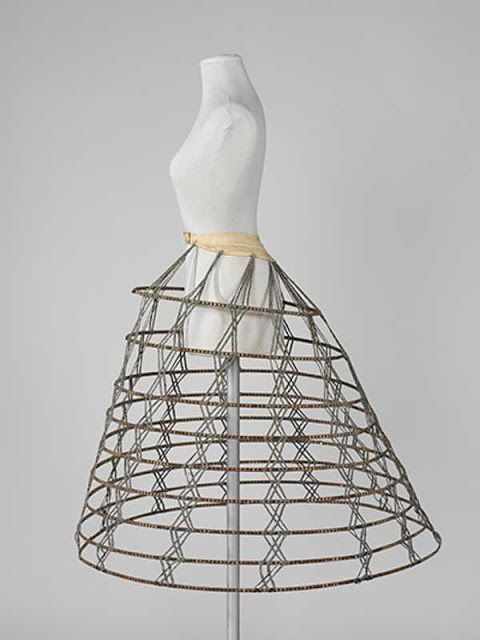

Here's also all of these foundational layers shown all at once, though I think the crinoline is from between 1866-68, since it's so narrow around the hips (the silhouette collapsed very quickly from the critical mass of 1865 to a much more narrow A-lined silhouette).
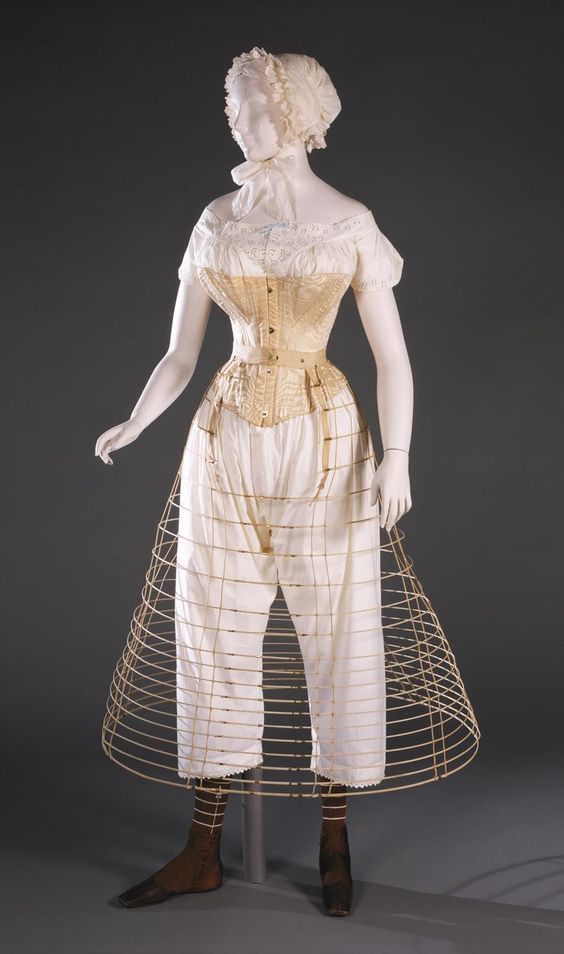
As said, this is really necessary to pull of the skirt of early half of 1860s. You really can't get the shape right without it. Especially for the earlier silhouette of the decade 1850s crinoline works perfectly fine and even the later 1860s crinoline like above. Even modern or 1950s hoop skirts can be serviceable here, but if the skirt is cut like in the mid 1860s, it definitely does need the elliptical crinoline that are very specific for those couple of years, as you'll see in the examples of the next section.
Petticoat
Petticoat's purpose in this era was mainly to smooth out the crinoline. It was therefore voluminous and usually made out of fairly stiff fabric, usually a bit heavier linen or cotton. There was often horizontal pleats around the hem, which would reinforce the shape. Couple of layers could be used too to properly cover the crinoline. It was pretty plain, usually white, but not necessarily, maybe with a bit of lace at the hem. Especially in early 1860s the petticoat was usually gathered with cartrigde pleats, which give a very round and voluminous shape. Around the mid 1860s, the pleating would be mostly focused in back to enhance the long shape.
Cotton petticoat from 1855-65 US, and linen petticoat from 1860-65 US. The first is very likely late 1855 or very early 1860s as it's so very round. The second is definitely closer to 1865, it shows very well how much more volume was at the back, as the hem there is much longer.
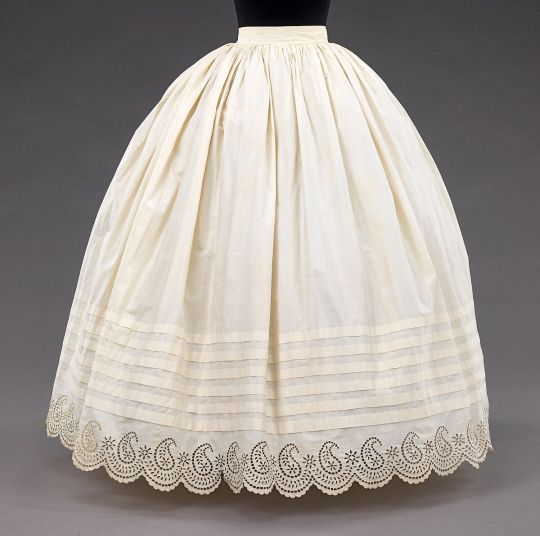
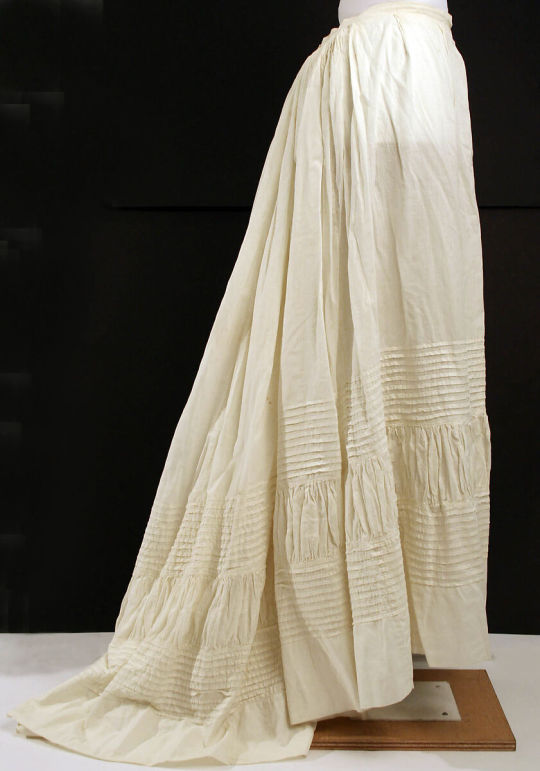
This is not strictly necessary, but it's very obvious when a crinoline doesn't have a petticoat on top of it, especially if the skirt is made out of some thinner fabric. It can be very simple, it just needs to be big enough. Basically any similar sized skirt or petticoat works fine in it's place.
Corset cover
Corset cover or camisole, as the name suggests, had similar purpose as petticoat, to smooth out the hard line of the corset. It was a small shirt, with similar neckline and sleeves as shift at the time. It was like other undergarments almost always white, often made out of cotton, but linen too.
Cotton corset cover from 1860 US, and another from 1864-68 US.
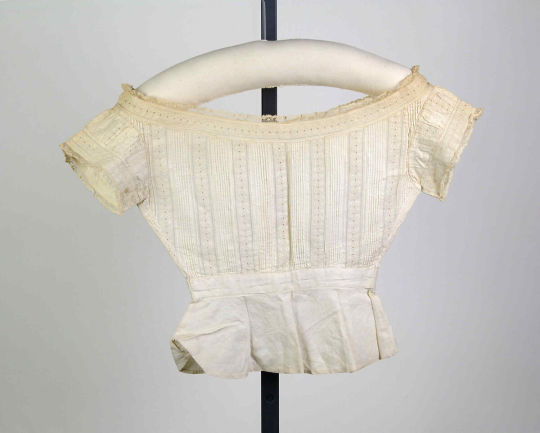
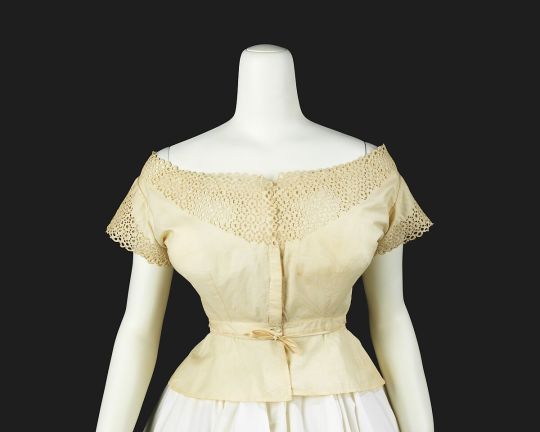
It's not super necessary imo, but it does give a smoother finish. It could be pretty easily replaced by a corset cover from different era, that's close enough in design (so it won't be showing under the bodice), if something like that is more easily available.. Any shirt really that's similarly loose-ish, so that it doesn't create too much bulk, but also doesn't get pinned tense by the bodice, would work I think.
Ball gown
Now we finally get to the meat of it. Ball gowns of the early half of 1860s had very tiny sleeves, that hung just over the shoulder. They were usually tiny poofs or could be tiny frills too. As mentioned earlier, the bodice was short and ended abruptly at the waistline, which was slightly above the natural waist, to emphasize the mass of the skirt. A typical waistline exaggerated pointed end.
The skirt was not as elaborately layered like a cake as in late 1850s, but typically it had a bit of layering at the hem, where the layers were displayed by different types of gathering. An organza layer on top was very popular. A bit of trimming at the hems of the layers of the skirt was common, but the amount of trimmings was pretty restrained (especially when compared to the next couple of decades).
The colors of evening wear were usually light. I've noticed white, light pink, light blue, mint and lavender crop up most often. It was though very trendy to have a dark or a bright jewel accent color combined with the soft dominant color. The new synthetic dyes were able to create cheep bright colors unlike before and people were very into them. The most popular colors, that were also used a lot as accent colors in evening wear were bright purple, magenta, electric blue and emerald green. The evening gowns tended to be solid color and mostly one color too, except for the accents. Typical decorative motifs were fabric flowers, bows, lace trimming and fringes. For evening wear the fabric was most often silk as taffeta or satin and possibly organza in addition.
Here's some select fashion plates with ball gowns I really like. The firs is from 1863 and the other two are from 1865.
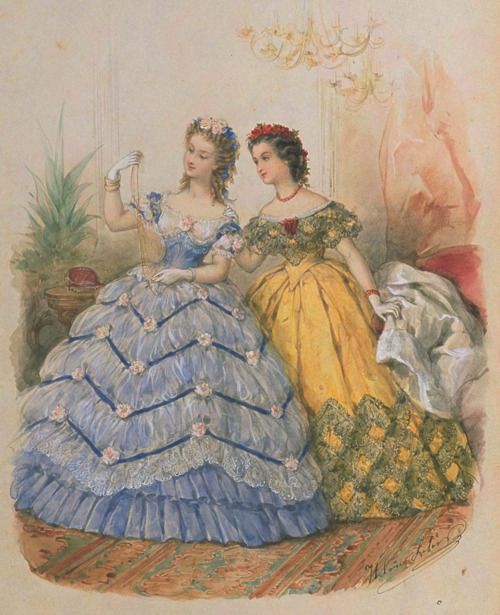

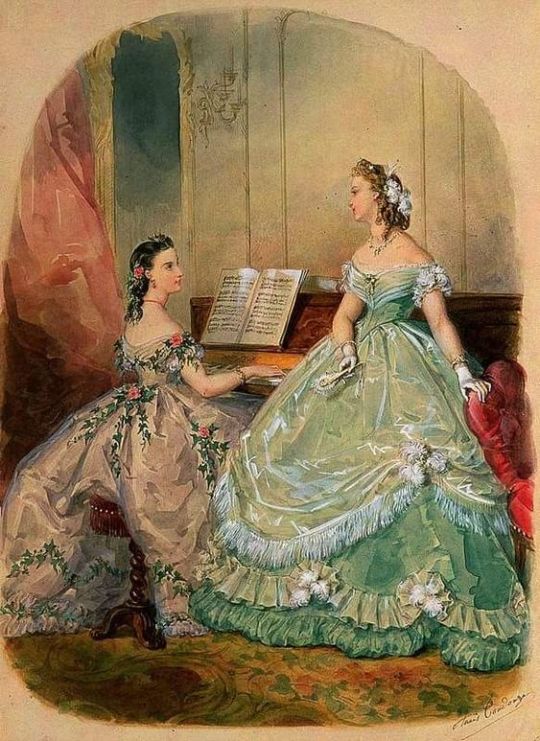
The first two include my personal favorite trend from this period, which is corselette/Swiss waist/Medici waist. It was a small decorative usually underbust waistwear, sometimes with shoulder straps, sometimes without. It was part of the Gothic Revival fashion and was alluding to Renaissance bodices and stays. They really have nothing to do with Medieval or Renaissance fashion, but Victorians associated the use of waistwear and stays as outer wear with vague idea of The Gothic for quite complicated reasons (I talk about that in this post at length). They were lightly boned, but just to keep up the shape, they were not in any way supportive, just decorative. The blue dress in the first example above has a Medici waist (the trend was loosely inspired by Catherine de Medici's portraits), which has the distinctive upward pointed neckline combined with shoulder straps, and the white dress in the second example has either Swiss waist or corselette. The terms were used quite interchangeably, even the Medici waist's definition is pretty loose (I usually just default to corselette). Below there's couple of more example of these. First is silk corselette from 1863-67 US and second is silk corselette from 1864-68 US. The third is a dress with another silk coselette supposedly from 1855 US. I think the bodice is too short for 1855 and the skirt very distinctly mid 1860s, with the volume in the back, so I won't believe MET on this. Interestingly the dress is made out of piña fabric, which is traditional fabric made out of pineapple plant fiber and was a luxury fabric among Western upper crust in 18th and 19th centuries for colonialist reasons.



Okay, I'm done with the corselette propaganda. I have a pinterest board of primary images with a section for 1860-65 for additional inspiration, but I haven't organized it yet, so there might be some misplaced images.
Accessories
These are not that necessary, but a bit of extra detail to sell the look.
Hair was kept in elaborate low buns, which could be decorated with fabric flowers and ribbons for the evening. Necklaces were pretty short and usually fairly simple. This was the time, when the iconic black silk ribbon collar became a thing. In 1860s it usually had some small (or bigger as in this royal example) pendant on it.


Gloves were strictly necessary. For evening they were always white kid (a type of thin leather) gloves, which just covered the wrists. Silk gloves were thought of as tacky. The gloves were very simple in style but bracelets were often used with them.
Above knee stockings were always used. Usually they would be white, but they did come in all kinds of colors and small patters on the ankle were common. They would be knitted silk for the evening. Here's some silk stockings in very fun colors and patterns from 1860s England. They were secured with with a wide silk ribbon tied below or above knee. I use stockings and ribbon to secure it for everyday purposes, and it works really well. The thing is to have wide enough ribbon you can circle around the leg couple of times, so it won't put too much pressure on one spot. For me below knee works the best. Really any thin knee high stockings works for this, and white is the safest bet.
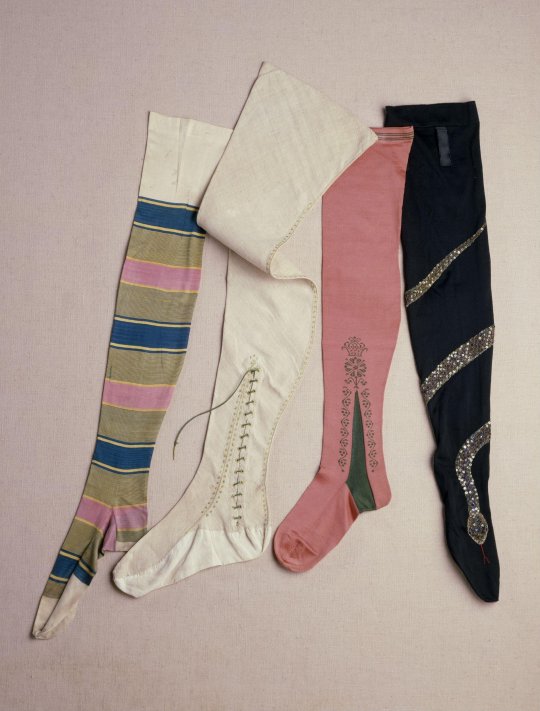
There's some options with the shoes. Both boots and slippers were acceptable for evening wear and slippers could have a heel or not. The evening shoes were less practical and fancier that your day shoes. They usually had silk as the fashion fabric, which wasn't that much of an issue, since they were used indoors.
Silk evening boots from 1860s France, silk slippers with a heel from 1855-65, and silk slippers from 1862 Austria.
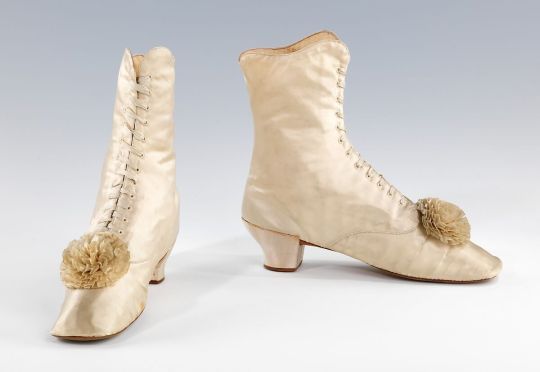
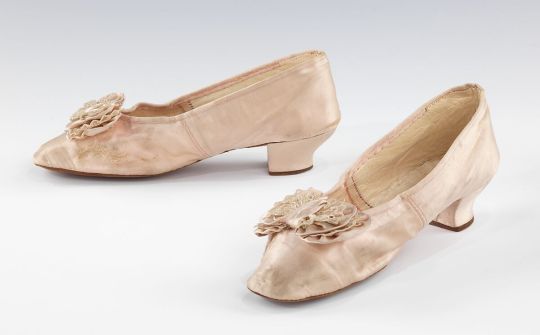
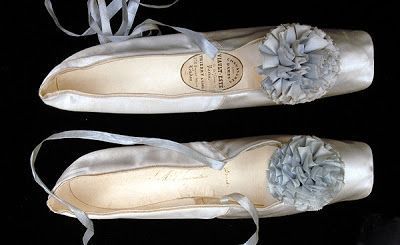
Honestly, shoes won't be really seen under the skirt, so I don't think it's very necessary to get new shoes (there are shoe sellers like American Duchess who do historical reproduction so it's possible). Basically any ballerina slippers with a somewhat flat or at least round end are pretty close. Also any shoes roughly between 1830-1880 are basically accurate (minus some details) as the shoe fashion changed pretty slowly.
I hope this was helpful for at least providing some background info!
#historical fashion#history#victorian fashion#fashion history#dress history#answers#historical costuming#extant garment#1860s fashion#fashion
134 notes
·
View notes
Note
This is a stick up
SHOW ME THE BABY GRILL (dusk)
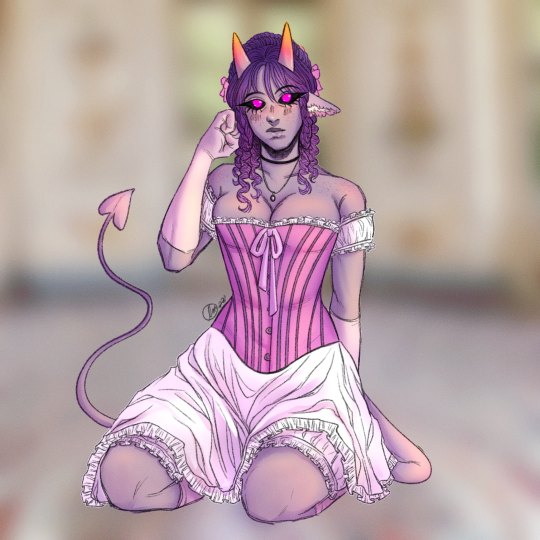
Very mildly historically accurate circa 1860s ball gown undergarments, since I've been seeing a lot of people talking about historical ghouls and (oops special interest)
I say mildly bc I could point out so many things that would be different or need to be added still but also like, it's a drawing of a demon so why would anyone care 😭 I'm pretty sure there's at least 3 other people who also hyperfixated on fashion history but the majority doesn't
106 notes
·
View notes
Note
Does this actually look like 1869 to you? zegalba (DOT) tumblr.com/post/722385349980094464/french-wedding-dress-1869
I'm confused by it!
here's the pic, for reference:


(It's in the Met Museum's collection right now, so I was able to find more pictures. It is in fact two pieces- unsurprising, since most dresses were back then.)
just in terms of era, yes, I would absolutely buy this for 1869. it's a sheer overdress, meant to go on top of an opaque under-layer (well, okay, several, but besides the wearer's undergarments. you understand), and it reflects a brief late 1860s trend for an almost A-line silhouette:
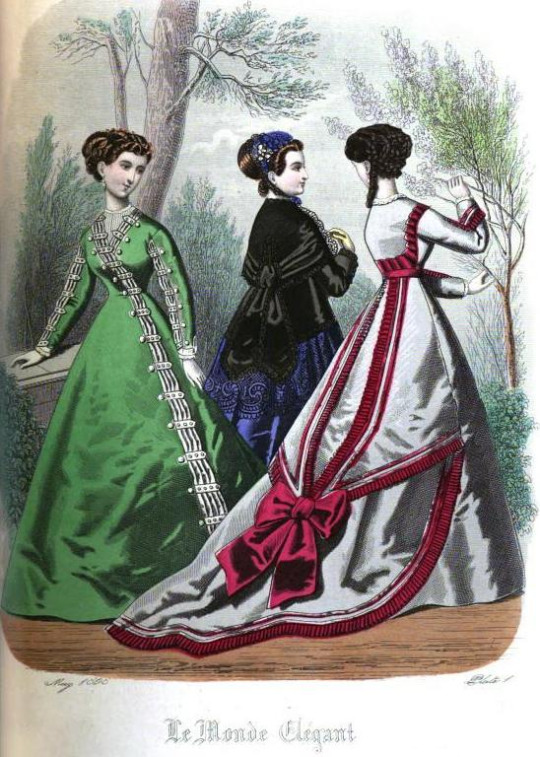
(Le Monde Elegant, May 1868. By 1869 you're starting to see a more proto-bustle look superseding the relatively slim skirts of the previous year, but there's still a version of this silhouette in the fashion magazines.)
Now, the classification of "wedding dress" is one I struggle with, in the case of non-white gowns. My guess is that this piece was donated by a descendant of the original owner, hence the very precise dating and the use designation. Except...our modern understanding of Wedding DressTM tends to be "dress that is immediately recognizable to any outside observer as a wedding gown, regardless of the context in which it is worn." And an overgown like this does not fit that bill. The owner could have continued wearing it for formal occasions, and very likely did, with no-one thinking it was odd or out of place. It's the dress she was married in, sure, but after the wedding it could have been part of her wardrobe as simply A Very Nice Overdress (With Extra Sentimental Value). I don't know if calling it A Wedding Dress properly conveys that to a modern museum-going audience.
But then, I'm broadly opposed to all categorizations of 19th-century non-sporting or lingerie clothing beyond "formal, semi-formal, casual" in museum descriptions, on the grounds that there was little consensus about what separated an "afternoon dress" and a "dinner dress" at the time (for example) and it perpetuates the myth that women changed their clothes a dozen times a day, so. There's that.
(I would have phrased it like "overgown, worn as a wedding dress," but that's just me)
Anyway! Hope this answers the question to your satisfaction.
#long post#dress history#1860s#victorian#marzi rambles#ask#anon#clothing history#fashion history#victorian fashion
108 notes
·
View notes
Text
We interrupt your regular medieval posting with 1860's underwear!



Before this, everything I made was at the latest 11th century, but I've wanted 1860's clothes for a while. I want to make a working woman's outfit, but before I can even think about the dress, I need all those lovely undergarments! So far I have a chemise, drawers, stockings, and garters. A humble beginning, but an important one!
5 notes
·
View notes
Text
wardrobe.
( 1830-1859. )

girlhood/pre-canon. girlhood in this era defined by the length of the skirt. depending on age, the skirt would end at a different place. until the age of fourteen, her the hem ended at her knees. johanna wore pantalettes with corded petticoats and wide skirts. sleeves were nicknamed " o'mutton sleeves " and copied the styles of adult women as they got wider. this was until the end of the decade where they became smaller and tighter. on top of this ensemble, she wore a dinner apron ( later known as a pinafore ).
turkey red was popular between the ages of five and seven. fashions then changed to yellow calico dominating her wardrobe between the ages of seven and ten. skirts would hit the knee until she turned fourteen when they dropped to the calves.
two years later, they were at the ankles. by seventeen or eighteen, johanna was considered a lady. skirts fell to the floor. accessories wise, johanna always wore a bonnet outside. as a child, these complimented the fashionable sugar curls. along with her cross on a chain, she also had coral and turquoise necklaces. ribbons were popular for any age.

canon. blue is the color of freedom, but johanna is a caged bird. the 1840s took a sharp turn from the billhouting and extreme silhouettes of the previous decades. opting instead for more modest styles. the sleeves of day dresses were straight and typically-long sleeved. skirts saw a it more decoration, but mostly frills and lace were reserved for evening gowns. johanna's wardrobe was controlled by turpin, who had her dressed very modestly. white was his favorite color on her. the color of purity is rather see-through at times. johanna prefers blues and pinks and violets. feminine colors. the patterns of her dresses were typically of flowers. johanna knew how to make her own undergarments and nightgowns and was beginning to learn dressmaking out of pure boredom. this allowed her to make small alternations to her clothes. a neckline was too low for her comfort? she would add a stitch here and there and it would look perfectly natural.
at this point, undergarments consisted of a shift ( or chemise, as they were called in france ), a corset, a pair of open drawers ( drawers that had a slit in the crouch... not inteded for intimate purposes ) and several petticoats. skirts were full, getting closer to the fullness of the 1850s and 1860s. several petticoats were used to achieve this silhouette. some were corded to enhance the effect. johanna wore as many as six petticoats at a time. partly for fashionable purposes, but partly because she was cold. this came down to her health. she also wore two pairs of stockings at times. these would be held in place by garters, either made from ribbon or fancier ones that turpin provided.
in act one, she has bangs that she put herself. they curl, achieving a style more fashionable in the regency, but she adored her bangs. much of her time was spent doing her hair. whether it ended up being worn down or was tied into something more stylish, she played with it all day. she did own a bonnet, though it was only used once or twice.
accessories weren't very important to her, aside from her mother's wedding ring which she hid in various places around her room to prevent turpin from taking it from her and a cross necklace. the cross symbolized her devotion to god and her faith... and was partly used a fidget toy.
most of her stockings, dresses, handkerchiefs, shifts, petticoats, etc. had something embroidered on them. she was bored. she liked to sew.
in fogg's, the uniform consisted of a pair of holey stockings, a dark, coarse underskirt that fell six inches lower than the dress and that white, calico dress that tied with strings around the waist and fell into a straight skirt. there was a pair of drawers, but no supportive garment for the breasts. no corset, no stays, as the doctors believed patients could strangle themselves with them. a straw hat was provided for walks around the grounds.

post-canon. after loosing her mother's ring and the cross necklace, johanna begins wearing the string of pearls anthony bought has a late wedding present religiously. they become a great sense of comfort. as she entered the new decade, she embraced the new styles. however, she wasn't always on top of them due to a lack of resources. this didn't deter her. johanna began to make her own dresses.
sleeves became wider. skirts much fuller. decorations popped up. these changes were subtle and slowly became more popular as the decade went on.
undergarments were very much the same. shifts, stockings, open drawers, petticoats all were very similar. however, johanna got to start adding pockets under her skirts. turpin saw no reason for her to have them. but as a married women and homemaker, they became essential. johanna made and embroidered her own with help from her in-laws. pockets were separate from the dress for many centuries. during this period, they were tied around the waist ( above the corset and petticoats ) and would be reached via a gap between the side seam in the skirt.
dresses were typically made in two sections: the bodice and the skirt. this made it easier to get into them and made it possible to mix and match outfits.
blue, violet and pink reign supreme in her wardrobe. however, she begins to adapt shades of green and some red. black is banned from her wardrobe as she doesn't want to mourn turpin at all. white can only be found in a few patterns. yellow is also uncommon as she believed it washed her out and clashed with her hair.
at night, she prefers to sleep in her shift. due to an incident that happened when she was fourteen with turpin, nightgowns do not feel safe for her. this was a popular choice for women to sleep in during this time as it was affordable and practical. nightgowns were more popular among the middle and upper-classes.
when going out, johanna layered shawls the way she layered petticoats. several on top of each other. she learned how to make her own later on. living by the sea brought several cold days throughout the entire year. capes were popular among her social class when she lived with turpin for outdoor wear. but johanna didn't own a single coat or cape during the rest of her life. she much preferred layering shawls. she owned one or two bonnets that she resented wearing since they messed up her hair.
speaking of, her hair began to reflect her new lifestyle. usually own freely, she easily embraced how the salt in the air impacted her curl pattern, making them more like coils. her bangs had grown out while in fogg's. instead of cutting them back, she cut those pieces into layers. in the beginning of her marriage while anthony was still sailing, she would spend much of her time doing her hair as she was still learning how to run a household like theirs. as the decade progressed, she had less time on her hands as she learned new things and her children were born. this lead to casual braids or wearing it half-up and half-down. her devotion and love for her hair never wavers. there just wasn't as much time as previously for it.
#i just really love these eras of fashion#some of my favorites to be honest#*❈ ‣ whence comes this melody constantly flowing? — ( meta. )#will this become a series where i ramble about her wardrobe across a variety of aus? very likely
4 notes
·
View notes
Text
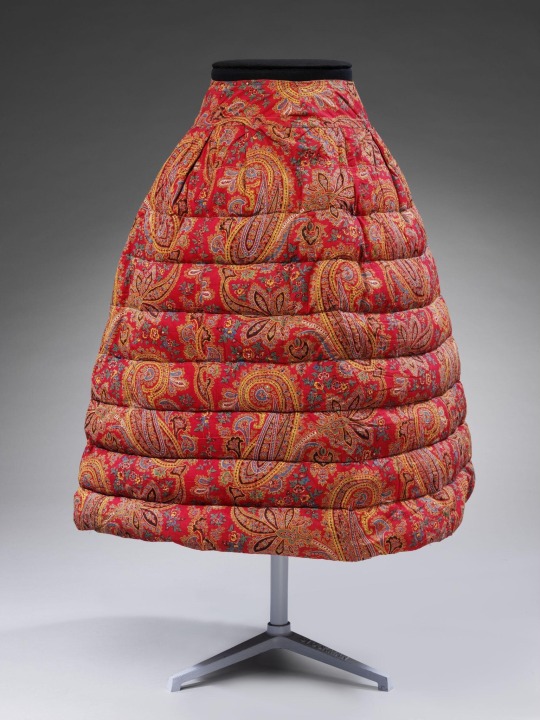
Red Printed Cotton Petticoat, ca. 1860, English.
By Booth & Fox.
Victoria and Albert Museum.
#booth & fox#red#petticoat#1860#1860s#1860s petticoat#1860s undergarment#undergarments#extant garments#womenswear#1860s extant garment#V&A#1860s England#1860s britain#British#English
103 notes
·
View notes
Text
fem!William cosplay
In honor of sherliam week 2023, I'm gonna start posting about my plans for a hopefully historically-accurate cosplay of William! :D
i'm planning on designing 4 outfits: professor, noblewoman day wear, noblewoman evening party wear, and traveling wear. I'm probably going to be actually making one of the first two or both. I could also throw in a teagown, loc outfit (though i honestly think it would just be the same as canon anyways?), sleepwear, specific design for undergarments, etc, but we'll see if i'm still interested in that later
when I first came up with the idea sometime in july or august, because i am such a historical costume girly, i was like, so i would do a male one except i know that i would never wear it outside of the cosplay, which would be a waste of my money and limited energy. So, i decided to just do a female adaptation of his canon character design and made a ~1878-1879 corset, with plans to make combinations (for that sweet sweet in-character practicality), corset cover, etc. Then, as i was working on the design, i ended up coming up with a whole au/justification for an actual female ver. of william that was publicly known in-universe as a woman who identified as such with the og william also being publicly known as a girl, because if he was still a boy, then f!william would have had to cross-dress. Also, if anything i'm saying is irl historically wrong, i'm literally begging for you to tell me and forward resources about what im wrong about.
So, essentially, in the 1860-70's, specifically including ~1876 - 1879, there doesnt seem to be as much popularity towards women being highly educated through universities or being teachers at universities as it is in the later victorian era, though there already has been precedent set for a couple decades of women graduating from college. So, if a female william (f!william for short) was a well-off and decently mid-high ranking noble lady from a family with an earl/count title, it could be presumed that trying to be a "perfect noble" (wo)man would not involve being more noticeably progressive in such an eye-catching manner. However, considering that in canon william doesnt try to downplay his intelligence at all publicly, given that he is known as a mathematical genius who graduated and became a professor at a very unusually young age, even f!william would probably be stubborn enough to fully go for it and achieve the same results, with a lot more opposition from strangers. Admittedly, a woman would not have been allowed to attend Eton, because it's all-boys, and being titled a professor means that you've been hired as a professor at a university, and i imagine it'd be hard to get a bunch of likely sexist-ass old men to hire a young woman as a professor, but let's say she did manage to do it, especially with the backing of a respectable noble family name. So that means she's a ~19 y/o publicly-known-as-21 y/o to ~23 y/o publicly-known-as-25 y/o who is going to be starting to teaching mostly young men, who are almost entirely well-off to noble status, in ~1874-1878. That's the tail-end of the first bustle era and in 1876 the natural form era starts until early 1880's. So i looked at a lot of fashion plates and extant garments from this general time period to get a sense of both eras to design a dress that was first made during the first bustle era to be fashionable to that time that was then retailored to fit the natural form era's fashionable silhouette but also not being too fashion-forward since i dont think she would try to keep up with that more than necessary as it isnt her priority, because it's possible, even likely, for f!william to be more practical/frugal by choosing to have an "older" outfit retailored to fit a new era's style than have an entirely new outfit made. Side-note, there is practically no way to pass off the button-up shirt collar design as a historically-accurate fashionable lady's collar, so dont @ me about that. Currently, this is the design i've settled on for the professor design, which would be worn while teaching at Durham uni and possibly also as daywear on the days she has to go to work there.
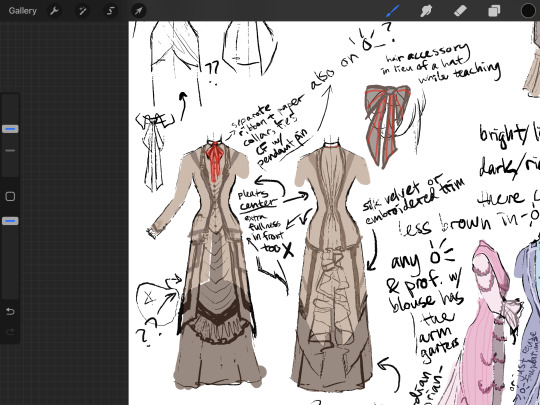
the dominating collar scheme for all the daywear options is brown, and while i could have used more red in accordance with the canon red tie and eyes, i again know that my wardrobe doesnt do red, so that wasnt really a choice in terms of the main body of the dresses if i want to be able to wear any of it normally. This one also needs to have the color layer updated. For the professor outfit, I was keeping in mind a relatively simple/modest design- for a noble lady- but especially in the back where male students would probably see a lot of (since she would be also writing on the blackboard), because anything too complicated or eye-catching could be "distracting". i didnt want to make it too modest because the students and coworkers are also of similar social class to f!william, so there is some expectation of dressing well for her station but also not being too distracting for the young male students :/ i'm still considering toning the design down more, but im not sure how....
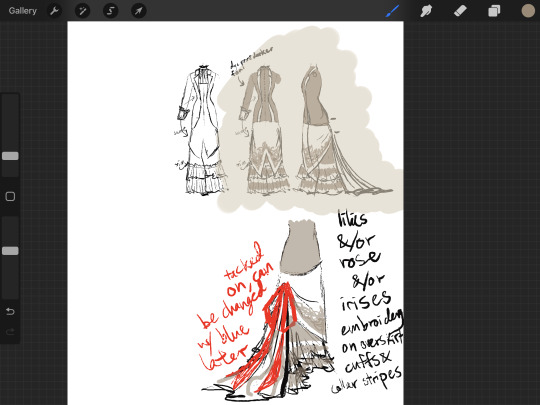
this is what i have for the normal noble lady daywear, hopefully appropriate year-round because i dont feel like designing a new outfit for like all 4 seasons. since it was by far more fashionable for women to wear brighter/lighter colors (usually more adorned by trims in matching/accenting solids rather than patterns for any time of year) during this time if it wasn't winter, in which case it would be dark but still rich colors, i made the browns a lot lighter to compensate for the fact that i'm trying to a. keep close to canon design and b. again, i want to be willing to actually wear it normally, so no reds or pinks as a main part. the big red ribbon will just be tacked on lightly so i can take it off when i'm not cosplaying. I also try to incorporate more of the pressed pleats trims as a nod to william's whole thing about perfectionism, precision, and preparation, as well as him being a math nerd, but like that also ties into the... 3 P's?? so *shrugs*. I also just love the trains of the natural form era so of course I had to add that here, where i can go wildly unpractical, in comparison to the professor one, which does have to account for a good bit of walking by foot across campus and possibly through town. this is also subject to change, but i like to think it's mostly set in stone here.
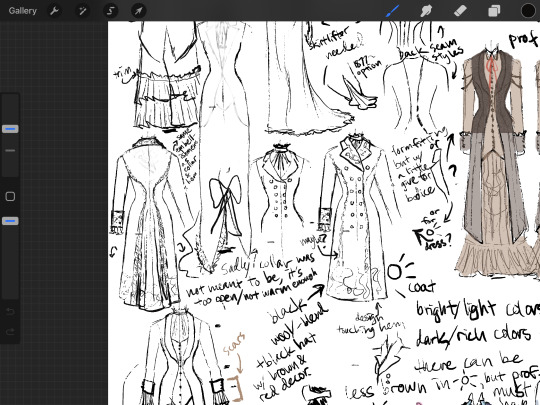
i also designed a black coat as a noblewoman adaptation of the one william wears in canon, which you can see him wearing when he and albert are at adam whitely's park opening speech. I'm not entirely sure about the exact nature and design of the embellishments, but its probably going to be some amalgamation of beadwork and embroidery. i'm actually also going to be making this, straight up because i want a black coat anyways lol. too bad it's not in time for this years winter. i didnt actually draw out the design for the hat but i was planning on a black base hat with brown and red decorations to tie it to any of the daywear clothes, including the coat, and maybe with a sheer white veil in the back? that was in fashion like during at least the mid 1870's. I'm also adapting the cane to an umbrella/parasol. while it'd make more sense to be a delicate litle parasol, i already have a normal-sized black umbrella with a silver metal handle, so that's like a perfect prop that mimics the dark wood cane with a metal handle that william uses in canon, though my umbrella doesn't have a sword hidden in it haha.
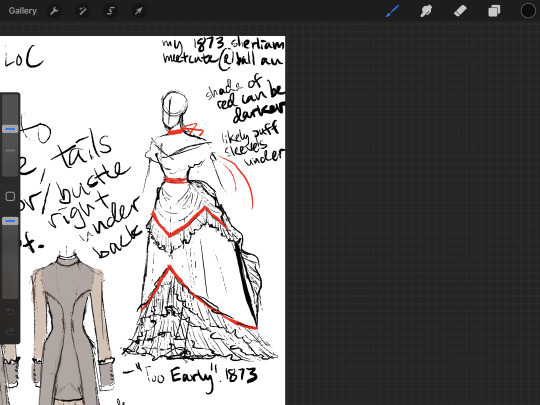
also, as a fun aside, in 1873, there was a brief trend for women to wear a ribbon choker that tied in the back with long tails as an evening wear accessory. so this is a sketch of a painting's outfit, dont remember the name though, that was painted in that year. Correction, I just saw that I wrote it down and its name is “Too Early”. I couldn't help but think up a fun little au of an au where f!william, who would be 18 y/o publicly-known-as-20 y/o, was at a ball and sherlock, male or female? (though i think a female sherlock would be kind of weird considering his canon bias that women are emotional, not as logically intelligent, and delicate :/), was also dragged there by mycroft or something when he decided?? to briefly visit england instead of presumably??? staying at whatever college he was studying at in paris. So, i was originally thinking that it would be such a cool image of sherlock lightly grabbing the tail ends of a red ribbon choker that f!william was wearing with a similar vibe as that sherliam manga vol. 14 cover art, as william turns to look over her shoulder at sherlock. But then, i obviously had to justify it to myself, so i came up with the whole above scenario and i guess they ended up meeting and becoming interested in each other a la canon but earlier and at some point in the night, william was teasingly staying (physically) one step ahead of sherlock and the image is when sherlock finally managed to catch william.
so i guess i'll post updates as i go? i'm definitely estimating this to be a year(s)-long project, considering all the research, patterning, and sewing i'll be doing. i'm also planning on doing a photoshoot with the cosplay when i'm done, so i'll be posting those whenever i have them ready.
edit: I just briefly skimmed a little of the history of female scholars, and apparently the first one to become a professor during the Victorian era is credited to Edith Morley, in 1908 at the age of 33, though there were some other women who also attended a male-dominated college around the same time as her in the 1890’s. Thus, for f!william to have been able to get that professorship or even attend and graduate from a college with a proper degree ~1869-1873, that would have been seen as even more extremely radical, which would have made her stick out in high society in a way that would make it harder to convince targets like lord Enders that she was similarly elitist and a “proper��� noblewoman. She also would have had to convince both count Rockwell, her guardian, and the college itself to allow her to attend at ~14 y/o publicly-known-as-16 y/o and maybe even graduate with a proper degree, probably through a lot of machinations on her part, not to even mention being a professor. The only advantage to be found is that she’s seen as a noble, so there is some influence to exert to match male-dominated college chairs.
9 notes
·
View notes
Text
Timeless re-rewatch - s1e02 (because I have no willpower)
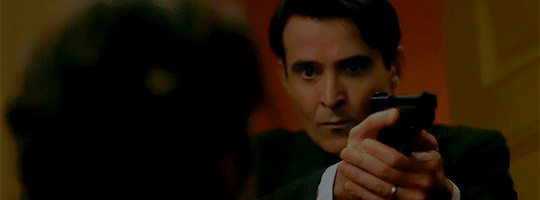
Th Assassination of Abraham Lincoln: so a lot of the US eras/events that Timeless visited, I didn't know much about, being a Brit. However, I did know a fair bit about Abraham Lincoln's end which helped in this ep.
As someone with a keen interest in historical fashion and an occasional costume maker, I love that we get to see Jiya helping Lucy into her 1860s undergarments 👍
Paperweights - you think Connor? 😆
I do love the Timeless intro with the date travelled to each ep featured. Simple but effective.
I like the plotline with Rufus (or Denzel Washington 😁) and the soldiers of colour.
First sighting of Karl, yay! Followed by the the world's worst Irish accent and the world's worst game of Operation 😆
Lucy goes tovthe train station and gets a date for the evening, but there's still more chemistry in the following scene with Flynn, even when they are yelling at each other 😁
Love that dress on Lucy, really want to make a cosplay of that one day 😍
I was unaware of the plot to kill Grant and Seward alongside Lincoln, so that was interesting to learn on first viewing.
The show is certainly not afraid of making Flynn the definitive bad guy at this point, making him kill Abraham Lincoln sermed a bold move! I love that Lucy managed to foil his attempts to change the timeline by killing , even though she's about half his size! The looks on both of their faces when he bursts in though 😱
"I wish I could have saved your father" "There was nothing you could have done" Guilt trip!
The paperweights seem to be working well 😁
I love the looks at the revised histories that they do in most eps and how members of the timeteam sometimes appear in them.
Double bombshell for Lucy at the end 😱😱 She deals with having a sudden fiance she's never met before way better than I would have done!
Starting to get bad vibes about Carol Preston there too 😒
#timeless re-rewatch#timeless#timeless s1e02#timeless - the assassination of abraham lincoln#lucy preston#rufus carlin#wyatt logan#garcia flynn#jiya marri#denise christopher#connor mason#carol preston#noah wyle#noah#abraham lincoln#robert todd lincoln#john wilkes booth#karl
6 notes
·
View notes
Text
Sneak peak of a future project (aka I still want to make a hoop skirt).


I've had Beatrice from Umineko no Naku Koro ni on my mind for YEARS and I think I'm finally at the skill level to execute this dress. If I can splurge on fabric costs, I'm thinking a silk taffeta for the underskirt at least, maybe taffeta or some other kind of silk for the overdress? I want it to be structured and I don't want it to seem too samey.
Now the thing with the understructure that you can probably see is that that as an elliptical hoop skirt. The outfit generally feels Victorian Era inspired (I'm not a historical fashion person, that's just my impression from some surface level research). There are some patterns out there available (1860's seem a popular time for elliptical hoop skirts. I think I can make this without a pattern though. The trick to the shaping seems to be the upper hoops being half hoops, and pulled back by ties.
I guess this finally gives me an excuse to make a corset (it's going to be a structured undergarment layer, and the bodice of the dress will just be a highly structured bodice supported by the corset). I'm planning to get a bunny suit made before I start that so I'll have a bit more practice with working with spiral steel.
I've got some things on my to-do list before this (mostly more Fire Emblem stuff - planning on bunnysuit Dimitri, FEH winter alt Dimitri, summer alt Sylvain). I also need to finish some parts for academy Sylvain, i.e. remake the belt and finish the 3d print officer's sword and lance of ruin. There's an Elster unit from Signalis plan that's going to have to fit in somewhere. This though is going to be the next big build, and I already have hoop steel so I might be able to go ahead and get started on that part since it's been too humid or rainy here to really do much with all the 3D prints in my backlog.
#cosplans#i don't feel like i really got to enjoy the judges award we got at momocon so i'm going to jump into the next project to cope
0 notes
Photo
French Cancan
Can-can
The can-can is a high-energy, physically demanding dance that became a popular music-hall dance in the 1840s, continuing in popularity in French cabaret to this day. Originally danced by couples, it is now traditionally associated with a chorus line of female dancers
The can-can is believed to have evolved from the final figure in the quadrille, a social dance for four or more couples. The exact origin of the dance is obscure
The dance was considered scandalous, and for a while there were attempts to suppress it. This may have been partly because in the 19th century, women wore pantalettes, which had an open crotch, and the high kicks were intentionally revealing. There is no evidence that can-can dancers wore special closed underwear, although it has been said that the Moulin Rouge management did not permit dancers to perform in "revealing undergarments

Dancer performing a pied en l'air

The Moulin Rouge featured in a Toulouse-Lautrec painting
It’s difficult to think of a dance style more emblematic and more closely associated to a venue and a specific time of history. The French cancan stole the show at the end of the 20th century, when such renowned French painters as Henri de Toulouse Lautrec painted posters for the Moulin Rouge and its most famous dancers.

An upbeat song, with a tune that has become iconic: the French Cancan music is part of the history of Paris as well as that of cabarets. The Moulin Rouge reveals the secrets of both this exhilarating melody and those of its creator, Jacques Offenbach.

Today the French Cancan continues to inspire both little ones and grown-ups on the stage of the Moulin Rouge!
THE HISTORY OF THE FRENCH CANCAN
But you have to go back to the 1820s to trace the origins of the French Cancan. At this time, both public and private balls were highly sought after by Parisians. Back then they danced the French Cancan with a partner, and there was no real place for improvisation. Tired of this rigidity, a handful of men decided to indulge in a few minutes of solo dancing, giving free rein to their imaginations while they let off steam. These moments were then christened ‘chahuts or ‘cancans’. It wasn’t long before women were at it too, far surpassing the men in their prowess, releasing shockwaves with their daring moves in the process. In 1831 there was even a law attempting to ban the cancan – in vain!
The rebellious spirit of the chahut saw the arrival of the first wave of female ‘chahuteuses’, including Queen Pomare and Céleste Mogador. Over time, the cancan became a tourist attraction. The British inventor of the music-hall, Charles Morton, added the term ‘French’ to describe this dance performed by the Parisians. This is how the name ‘French Cancan’ was born. In reality the dance derived from the ‘naturalist quadrille’, a ballroom dance that was very much in vogue in the early 19th century.
The movement ended up becoming more professional from 1860 onwards, and cabaret posters slowly began to appear across France. Then, in 1868, both male and female dancers reappropriated Orpheus’s Infernal Galop, with the tune becoming inseparable from the French Cancan. In the 1920s the artistic director of the Moulin Rouge, Pierre Sandrini, decided to remove all improvisation to make way for compulsory dance moves. Back then the cabaret cancan owed its popularity to the performances of its dancers turned celebrities: La Goulue, Nini Patte-en-l’air (Nini Legs in the Air) and Grille d’Égout (Sewer Grate).
Born in 1868, Jane Avril was among the Moulin Rouge dancers who made a mark on their time. Unlike other dancers, particularly La Goulue, she didn’t remove her clothes or offer herself to men. Thanks to her, the French Cancan was exported to cabaret stages across the whole of Europe, and Jane became painter Toulouse-Lautrec’s muse.
The Moulin Rouge and the emblematic French Cancan music








French Cancan (1955) dir. Jean Renoir
372 notes
·
View notes
Text
The Victoria Era

The Victorian era spans over 63 years, the reign of Queen Victoria’s over Great Britain and Ireland from 1837 until her death in 1901. This era was time of great wealth and power, Britain's expanding empire, a period of rapid advancement in science, industry and the arts, and saw much political and social reform, many of which we know today.
Before, the Victorian times, men were the focus of fashion however as a result of having a Queen in power women soon become the forefront in fashion, many clothing styles came and left during her time on the throne and she very quickly became the fashion icon of her time. Women's fashion was largely dominated by corsets, bonnets, top hats, bustle, petticoats and full skirts which gradually made there way to the back of the silhouette. Although, at the end of this period we started less restrictive clothing emerge.
By the end of the Victorian Era, as the development of the Princess Line and increased activity of women, the skirts had decreased in size.
The Crinoline

Crinolines were worn by women of every social standing and class across the Western world, from royalty to factory workers. The crinoline appeared on the fashion scene in the mid-1800s, made from a stiff material using horsehair and linen, as well as the framework consisted of round/oval circles, shaped like a hoop, preferably, made out of steel however alternative methods were used, such as whalebone, cane, gutta-percha, and even inflatable caoutchouc, which is a natural rubber. Imaginably, they were heavy, hot, unhygienic, uncomfortable and also extremely wide, at its widest point, the crinoline could reach a circumference of up to six yards making it difficult for women to simply, pass through doors, boarding carriages and generally moving about therefore, on occasions crinolines became especially hazardous to women, resulting in freakish accidents, although by the late 1860s, crinolines were beginning to reduce in size.
Bustles

The bustle was introduced as a distinct undergarment during the 1870s, supporting skirts which no longer sat over a crinoline, but which were gathered up at the back, projecting out below the waist. Padded with cushion, or arranged with steel springs, the surplus fabric was draped and the dress was pulled into shape, for support a drapery small crinoline was provided with an additional steel frame which was attached to the back at the waist. Whilst skirts narrowed waists lowered to contrast with the elegant tight bodice and flat fronted skirt.
On top of clothing the hairstyle also changed between the eras. In the 1870s, there was fullness of ringlets and plaits falling to the shoulders decorated with ribbons, bands and combs, hat were often wore as well, often very low, tilted forward and small to embrace the hair underneath it.
Corsets.

The focus of the stylish feminine silhouette of the mid and late 19th century was an hourglass figure with a tiny waist which was often achieved through the use of corsets. Typical Victorian corsets didn’t end at the hips but flared out and reached several inches below the waist. Corsets were constructed of whale bone in pervious years, however steel replaced this element of a corset from 1860-1890. Although, the tighter they got the more dangerous they got, promoting promiscuous views of female bodies, but women did sacrificed their health for the sake of fashion there waist size would vary anywhere from 54cm to 81cm.
Dress reform Movement.
Women believed the dress code had gone too far women’s clothing consisted of constricting corsets, tight-fitting long sleeves, long and wide hooped skirts, and tight-fitting, narrow shoes. Women’s clothing limited movement and the activities they could engage in and the dress reform movement sought to reform dresses for women’s health and well-being whilst challenging gender norms and societal expectations for women.
Women's underwear.

Women's ready made underwear began being sold from the late 1840s. The first layer of clothing were bloomers, pantaloons, or drawers that acted as underwear. Most drawers worn by women in the mid-1800s were knee-length and split down the centre. Split drawers were a necessity for most women, with all the layers. The crotch seam was left open and there was an overlay for the garment to tie up. The most popular fabrics for these undergarments were linen trimmed with lace, however, plain cotton was most affordable. Some underwear was worn as support due to the bustle fashion of the 1870's as they required support and shaping from the hour glass coreset, tournures and petticoats.
The Japanese Influence and "Fans".

During the mid-19th century, Japan opened trade with the West which inspired an intense fascination with Japanese art and culture. Kimono fabric and fabric with Japanese motifs, such as birds, fans, flowers, and fish, captured the eyes of the western women, they were being used to make dressing gowns and tea-gowns. Along with the Japanese influence came a very popular accessory of fans.


The tea gown was an elegant pre-dinner garment intended to be worn at home while greeting receiving people. As with most other 19th century garments it did not require to be worn with a corset underneath. This level of comfort was only permissible in one's own home.
"Land of the Rising Sun"

This evening dress was made in 1894 with the sunburst of clouds highlighting an oriental influence, which was very popular during the Victorian Era. The evening dress was, clearly, influenced by the Japanese Kimono and a motif of the 'morning sun with clouds' which forms a powerful association with 'the land of the rising sun' from 1894.
0 notes
Text
Historical Fashion Rant incoming ↓
about the LA Ghost show orchestra ghoulettes because!!


At first I was really intrigued by the silhouette, having seen this post about it being a Victorian mourning gown, which while it IS mid Victorian in silhouette, I decided to do a little research to pinpoint exactly what says Victorian about their gowns!!


these are 1860s mourning dresses and an American mourning dress circa 1845 from the MET museum. However the following is a 1860s Englishwoman's Domestic Magazine walking dress plate. in which you can see a near identical black (not mourning) dress.

the kind of bell bottom sleeves used in the mid-late Victorian period were called pagoda sleeves, and we actually have several MET Museum dresses that have both pagoda sleeves and buttoned fronts.



(green plaid dress 1865) Brooklyn costume collection at the MET, and (light patterned cotton dress) MET museum, (B&W picture embroidered) French 1863 dress, also MET collection.
So we've seen that the dress is not a mourning dress nor a 1860s day dress... So what is it??
The silhouette is actually that of a mid-late 1830 early 1840s dress, the closest I found was a 1837-1840 dress from the Victoria and Albert museum in London

though there are very similar dresses with similar patterns dated in that same half decade range from 1835-1840 with similar patterns


this shape is very similar to Victorian ball gowns which also had that off the shoulder, mid waist, puffy skirt silhouette.
but what is the difference?? Quick history lesson:
During the English Regency before Queen Victoria is crowned, the fashion became very simple, going from your typical sac/robe gown, to the typical "regency" empire waist dresses that shows like Bridgerton are inspired by (I have a lot to say abt that but I wont)



The official regency ends in the 1820s, though the historical period is usually extended until 1837, when Queen Victoria is ascended to the throne. (British monarchy is just easier to timeline lol) So that in between period from 1820 to 1840 is a period where we see old fashions and new fashions merge, the empire waist lowers down and sleeves come back but they get all silly and weird, the skirts also go through some weird crinoline bustle eras, but we get that "All-Victorian" influence from it.
So the Ghoulette gowns, are 1830s black embroidered day dresses with 1860s button inspiration (looking at the fabric in the pictures I WOULD guess its some sort of Silk... I am however not sure if it is dupioni, taffeta, or satin texture)
As for the accessories, they clearly are not wearing bonnets though there are several fashion plate sources with Caps used throughout the 1830-1840s that would make sense, while the Veils are mourning veils, they are also too decorative to be seriously taken as Mourning veils without it being considered "flashy" or "distasteful" and well... the muzzles...
So overall.. while the gowns are SOMEWHAT historically accurate (I am assuming except for undergarments, though I may be incorrect) the hair/head dress/accessories are very much just costum-ey fun for the theatrical aspect of the shows
ty for reading my fashion rant <3!
Wait does anyone actually have that picture of the cello ghoulettes/? From the LA shows because if I'm correct it is a historically accurate ISH 1860s ballgown-
#raven rambles#the band ghost#nameless ghouls#ghost bc#ghost the band#nameless ghoul#the nameless ghouls#namelessghoulettes#ghoulettes#nameless ghoulettes#ghost band#band ghost#ghost ghouls#ghostbc#unmasked ghouls#maskless ghoul#maskless ghost
209 notes
·
View notes
Text

Red Wool Cage Crinoline, 1860-1865, British.
Victoria and Albert Museum.
#V&A#red#wool#cage crinoline#crinoline#steel#womenswear#extant garments#1860#1860s#1860s crinoline#1860s undergarment#1860s britain#British#1860s extant garment#19th century#undergarments
57 notes
·
View notes
Text
New chemise! Made from an old bedsheet. My old one didn't fit right and was getting pretty old. I'm really happy with how it turned out!



A chemise is an undershirt/dress worn under a corset to keep it from chafing. This is a simple version of an 1860s chemise.
#little women era#historical clothing#historical sewing#1860#civil war#civil war era#undergarments#chemise#old bedsheet cotton
6 notes
·
View notes